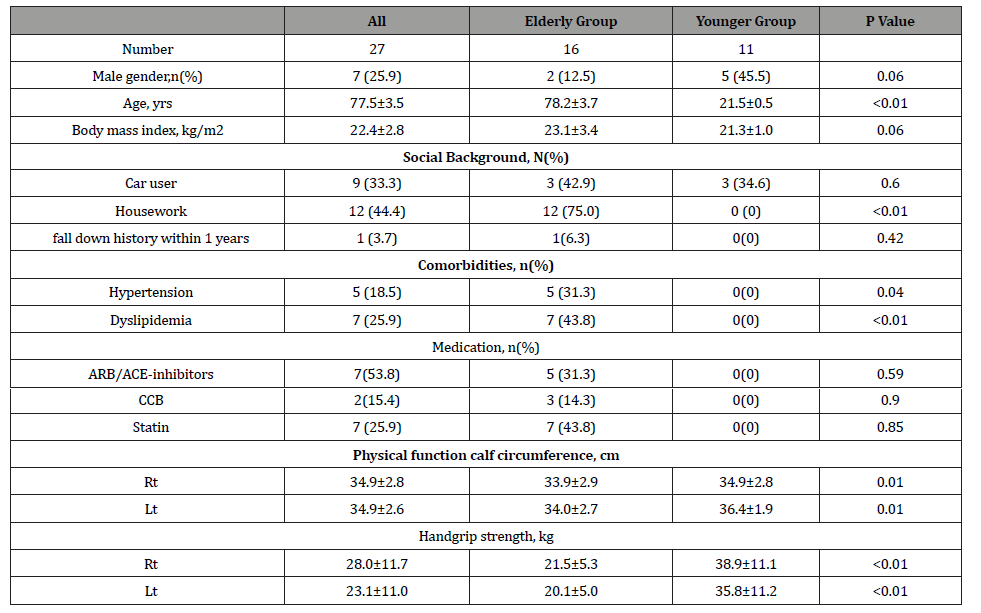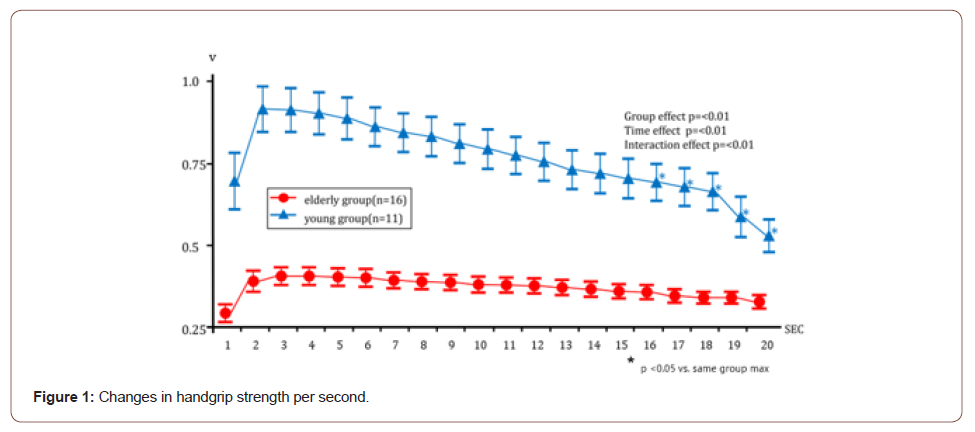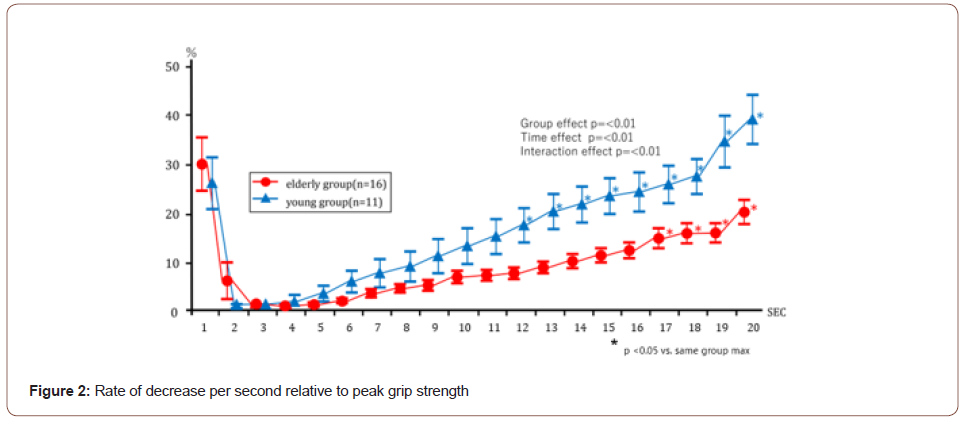 Research Article
Research Article
Handgrip Endurance in Healthy Elderly People
So Miyahara*, Yoshihiro Tanikawa, Hideo Hirai, Seiji Togashi
Department of Rehabilitation, Faculty of Health Sciences, Hiroshima Cosmopolitan University, Hiroshima, Japan.
So Miyahara, Department of Rehabilitation, Faculty of Health Sciences, Hiroshima Cosmopolitan University, 3-2-1 Othukahigashi, Asaminami ward, Hiroshima, 731-3166, Japan.
Received Date: May 22, 2020; Published Date: June 4, 2020
Abstract
The ongoing research in genome editing and gene silencing methods have paved a number of ways in not just detecting the diseases but also in rectifying it too. CRISPR Cas9 technology has been a gift in the field of genome editing technology. CRISPR Cas9 not only helps in identifying the diseases located in a particular gene but also helps in correcting the gene in its genome level by either silencing the gene for generations or replacing the defective gene and modifying it. With the help of CRISPR Cas9 replacing concept the defective gene is replaced with the new one and the disorder is not continued further. This advancement in the technology is the key benefit for the CRISPR Cas9 procedure. To add with it zincfinger nucleases (ZFNs), transcription activator-like effector nucleases (TALENs)are the other two technology to contribute in genome editing too. Haematological disorders being lethal in nature have found a cure via CRISPR Cas9 technology.
Keywords:Handgrip Endurance;Elderly
Abbreviations ED:Handgrip Endurance
Introduction
There are many evaluation methods that can measure physical function for many peoples [1-4]. The assessment of sarcopenia and flail is of great clinical and research interest and is growing rapidly[5,6].The theory to be related to these two evaluations has also been clarified, and in recent years, a new standard for sarcopenia has been created, and it is also used in hospitals and exercise facilities used by the elderly[6]. Among them, the hand grip strength is particularly easy to use because it can be easily measured in a short time.The Asian Working Group for Sarcopenia (AWGS) explains that the standard value of grip strength of sarcopenia, which is considered to be low muscle strength, is less than 28 kg for men and less than 18 kg for women[6]. Lifestyle interventions in the elderly, especially exercise and nutrition, have become the mainstay of treatment to improve this low muscle strength. These operations are also preventive measures for the elderly requiring long-term care, which are faced by countries entering a superaging society.There are many evaluation items based on grip strength[7-9], but few studies have evaluated handgrip endurance (ED) [10]. In addition, there are no studies that measured and compared the difference in ED changes between the elderly and young people, and the change with elapsed time (seconds). And there are few reports that examined the measurement time of grip strength in the elderly.
Therefore, the purpose of this study was to compare and consider the changes in ED of healthy elderly people and ED of young people with elapsed time (seconds) and changes in grip strength measurement time, respectively.
Materials and Methods
The subjects were 16 elderly people aged 65 and over (2 males, 14 females, 78 ± 3.8 years old) who performed light intensity exercises once a week. They all live in Hiroshima City, Hiroshima Prefecture. As a comparison group, there were 11 healthy young people (5 males, 6 females, 21.5 ± 0.5 years old). The measurement was performed in January 2020, paying attention to the prevention of the spread of infectious diseases caused by COVID-19. Subjects with diseases that may affect grip strength measurement were excluded (patients with severe heart failure, end-stage renal disease, malignant tumors, dementia, severe chronic lung disease, and those unable to walk 20 m or more). This study was anonymized based on the protection of personal information and data was obtained with the approval by Hiroshima Cosmopolitan University Ethics Committee (2019004).
For grip strength measurement, a digital grip strength meter (T.K.K.5401 Takei Kikai Kogyo) was digitally output using a strain amplifier (T.K.K.1268 Takei Kikai Kogyo) and an A/D converter (T.K.K.5721 Takei Kikai Kogyo) for measurement and analysis.
The sampling rate of Handgrip Endurance was set to 1/100, and the average value of the measured results was calculated per second. The subjects did not have a backrest in the chair, bent their knees at right angles[11], placed their soles on the ground, and bent their elbows on the measuring side at right angles, and measured their dominant hand with maximum force for 20 seconds. Then, the maximum grip strength value and the average value per second were calculated. The subjects measured calf circumference in the same posture[11].
Commercially available software (SPSS ver.26 IBM) was used for the analysis. In the data, the table shows the mean ± SD and the figure shows the mean ± SE. Continuous variables are displayed as average values. p value of less than 0.05 was considered statistically significant.
Result and Discussion
Result
There were significant differences in social background (age and BMI) and maximum grip strength between the elderly and young groups (21.3 ± 5.3 kg vs. 38.9 ± 11.1 kg, p <0.05). The continuous grip strength for 20 seconds was significantly different between the elderly group and the young group (Interaction effect p <0.01). The average grip strength value per second was the maximum after 3 seconds for both the elderly and the young. The younger ones showed a significant decrease from the maximum value after 16 seconds, but the elderly did not. The rate of decrease per second with respect to the maximum value was also significantly different between the elderly group and the young group (interaction effect p <0.01). In the young group, the rate of decrease was small 3 seconds after the start and decreased significantly after 12 seconds. In the elderly group, the rate of decrease was small 3 seconds after the start and decreased significantly after 16 seconds.(Figure 1,2) (Table 1).
Table 1: People Characteristics, Physical Function Data



Discussion
In this study, the hand grip endurance of the dominant hand in healthy elderly people was measured with maximum force for 20 seconds. Then, we examined the differences from young people, changes with time (seconds), changes in ED due to lifestyle, and grip strength measurement time.
Handgrip endurance within elderly people
It has been reported that endurance differs depending on the BMI range for young people[12], but in this experiment, no difference was observed between the elderly and young people depending on the BMI range, especially BMI 25 or higher (interaction effect p = 0.95).
Jakobsen et al. report that grip strength endurance is not a valid measure for assessing physical activity or quality of life in healthy subjects[13]. Miyahara et al. report that subjects performing household chores are more likely to maintain their physical activity and are less likely to lose their physical activity even with a state of emergency declared by COVID-19[14]. We calculated the difference in endurance of grip strength due to the engagement of housework in this case but found no difference in the decrease in endurance per second (interaction effect p = 0.90).
Maximum grip strength measurement time
Grip strength is said to have a significantly higher risk of total mortality, cardiovascular mortality, and other mortality as the aging decline increases[15,16]. In the reports on grip strength measurement, there are various reports that the grip strength measurement time is not set, and it is 3 to 5 seconds (17). The maximum muscle strength in this case was maximum 3 seconds after the start of measurement. From the above, it is desirable to measure about 5 seconds to measure the maximum muscle strength.
Conclusion
The elderly group did not show a significant decrease in the duration of grip strength for 20 seconds and exhibited a certain weak force. When it is required to exert momentary force, such as opening and closing the lid of a bottle in daily life, if this cannot be achieved, it may be necessary to take measures such as using selfhelp tools. In the future, we would like to find out whether there is a relationship between hand grip endurance and other physical function endpoints and cardiovascular risk (increased blood pressure).
Acknowledgement
None.
Conflict of Interest
None.
References
- Hsieh LE, J Sidney, JC Burns, DL Boyle, GS Firestein, et al. (2021) IgG Epitopes Processed and Presented by IgG (+) B Cells Induce Suppression by Human Thymic-Derived Regulatory T Cells. J Immunol 206(6): 1194-1203.
- Schulten V, L Westernberg, G Birrueta, J Sidney, S Paul, et al. (2018) Allergen and Epitope Targets of Mouse-Specific T Cell Responses in Allergy and Asthma. Front Immunol 13(9): 235.
- Kasprowicz V, A Isa, T Tolfvenstam, K Jeffery, P Bowness, et al. (2006) Tracking of peptide-specific CD4+ T-cell responses after an acute resolving viral infection: a study of parvovirus B19. J Virol 80(22): 11209-11217.
- Shoda H, K Fujio, K Sakurai, K Ishigaki, Y Nagafuchi, et al. (2015) Autoantigen BiP-Derived HLA-DR4 Epitopes Differentially Recognized by Effector and Regulatory T Cells in Rheumatoid Arthritis. Arthritis Rheumatol 67(5): 1171-1181.
- Schulten V, JA Greenbaum, M Hauser, DM McKinney, J Sidney, et al. (2013) Previously undescribed grass pollen antigens are the major inducers of T helper 2 cytokine-producing T cells in allergic individuals. Proc Natl Acad Sci U S A 110(9): 3459-3464.
- Rivino L, EA Kumaran, V Jovanovic, K Nadua, EW Teo, et al. (2013) Differential targeting of viral components by CD4+ versus CD8+ T lymphocytes in dengue virus infection. J Virol 87(5): 2693-2706.
- Snyder TM, RM Gittelman, M Klinger, DH May, EJ Osborne, et al. (2020) Magnitude and Dynamics of the T-Cell Response to SARS-CoV-2 Infection at Both Individual and Population Levels. medRxiv.
- Pianta A, S Arvikar, K Strle, EE Drouin, Q Wang, et al. (2017) Evidence of the Immune Relevance of Prevotella copri, a Gut Microbe, in Patients With Rheumatoid Arthritis. Arthritis Rheumatol 69(5): 964-975.
- Kamradt T, B Lengl-Janssen, AF Strauss, G Bansal, AC Steere (1996) Dominant recognition of a Borrelia burgdorferi outer surface protein A peptide by T helper cells in patients with treatment-resistant Lyme arthritis. Infect Immun 64(4): 1284-1289.
- Powlson J, D Wright, A Zeltina, M Giza, M Nielsen, et al. (2019) Characterization of Antigenic MHC-Class-I-Restricted T Cell Epitopes in the Glycoprotein of Ebolavirus. Cell Rep 29(9): 2537-2545 e2533.
- Owen DL, SA Mahmud, LE Sjaastad, JB Williams, JA Spanier, et al. (2019) Thymic regulatory T cells arise via two distinct developmental programs. Nat Immunol 20(2): 195-205.
- Sette A, J Alexander, J Ruppert, K Snoke, A Franco, et al. (1994) Antigen analogs/MHC complexes as specific T cell receptor antagonists. Annu Rev Immunol 12: 413-431.
- Franco A, C Ferrari, A Sette, FV Chisari (1995) Viral mutations, TCR antagonism and escape from the immune response. Curr Opin Immunol 7(4): 524-531.
-
So Miyahara, Yoshihiro Tanikawa, Hideo Hirai, Seiji Togashi. Handgrip Endurance in Healthy Elderly People. Arch Biomed Eng & Biotechnol. 5(3): 2021. ABEB.MS.ID.000615.
-
Ovarian Cancer Case, CellSonic, Tumour, Diagnostics, Oncologist, Electrical field
-

This work is licensed under a Creative Commons Attribution-NonCommercial 4.0 International License.






